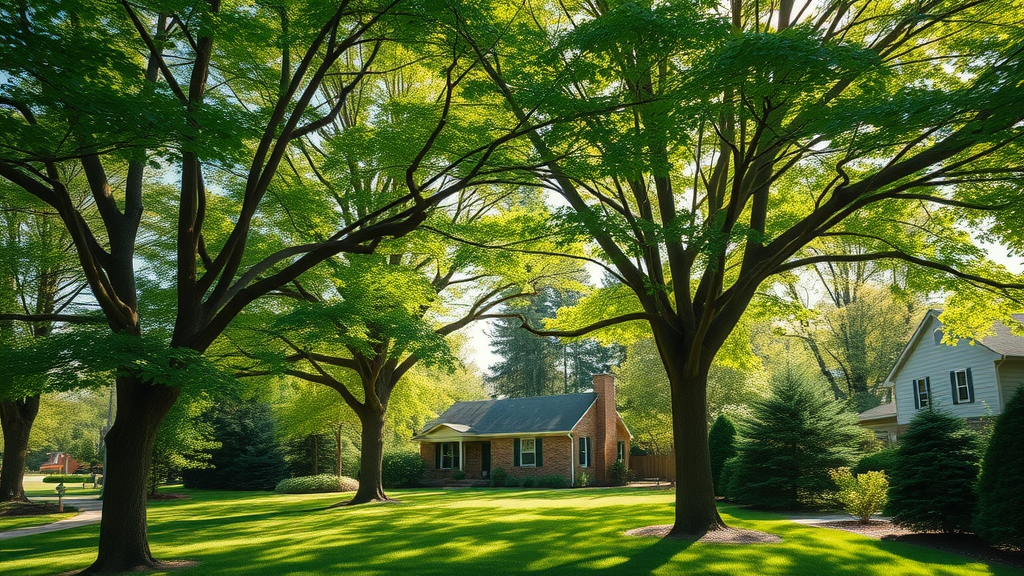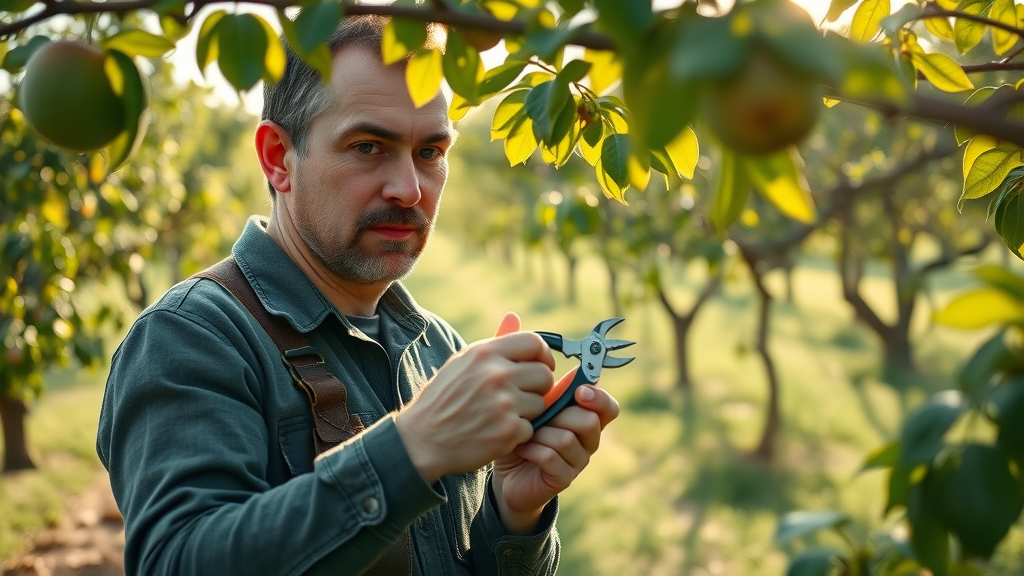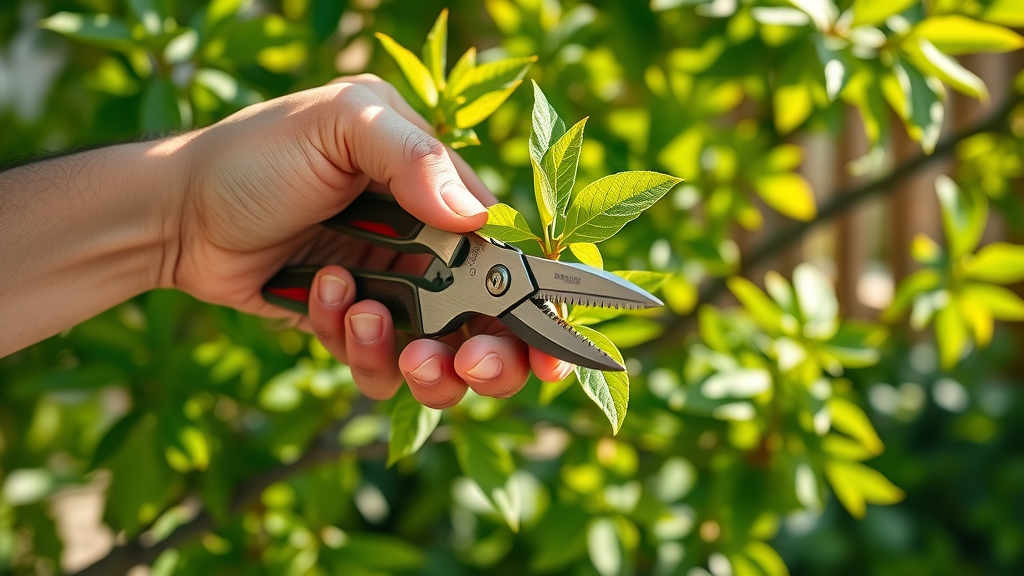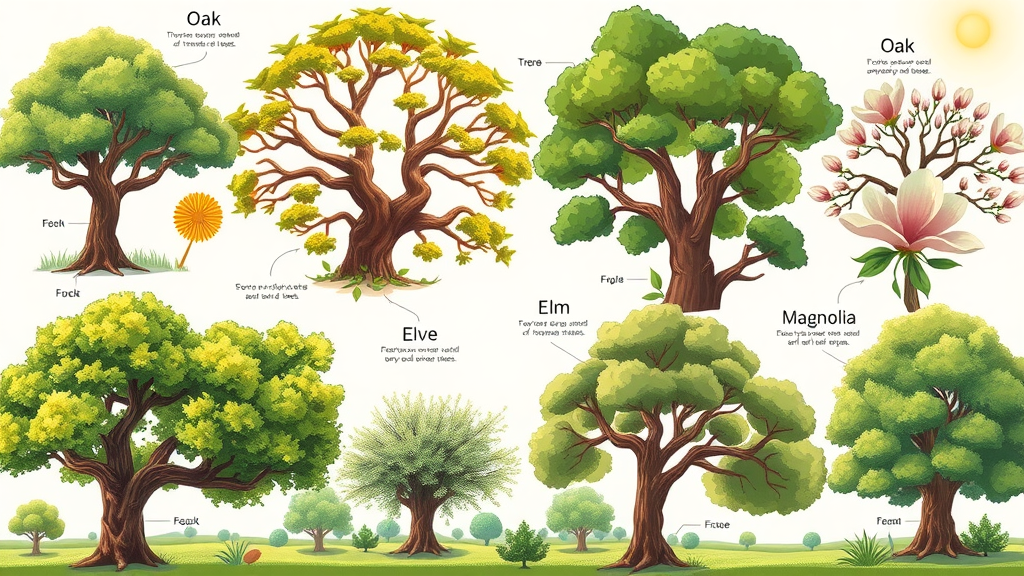Do you know which summer pruning practices actually help your tree—and which put its future at risk? When the heat is on, your trees are in their most active season. Understanding tree health and summer pruning gives you the power to nurture thriving, resilient trees—and a landscape that wows year-round. Dive in to learn the critical, often-overlooked truths behind summer tree care and take your yard's health and beauty to new heights.
Why Tree Health and Summer Pruning Matters: What Most Homeowners Overlook
- Discover why tree health and summer pruning are critical for vibrant yards and landscapes.
- Summer pruning impacts tree health, appearance, and longevity—even when conventional wisdom says it's risky.
Maintaining tree health and summer pruning isn't just cosmetic—it's strategic. Many homeowners assume all pruning should be done during the dormant season, but summer presents special opportunities and risks. Pruning trees in the summer can effectively target unwanted growth, improve sunlight penetration, and enhance air circulation, all of which contribute to overall tree health . Ignoring these key summer techniques may cause your yard to suffer, with trees that appear lackluster or, worse, face long-term health issues.
Another aspect often overlooked is the impact of summer pruning on disease management. Removing diseased, dying, or pest-infested limbs during the active growing period can prevent spread throughout the tree and neighboring specimens. Yet, it demands careful timing and skilled judgment—too much or ill-timed cuts can stress trees in the heat, potentially shortening their lifespan. A vibrant, healthy landscape starts with understanding why strategic summer pruning matters more than most realize.

Essential Elements of Tree Health and Summer Pruning
Understanding Tree Health for Trees in the Summer
During the intense sunlight and soaring temperatures of summer, trees in summer face accelerated growth as well as potential stressors like drought, heat, and pest invasion. Optimizing tree health relies on supporting their vital processes: efficient photosynthesis, robust nutrient transport, and stable moisture retention. Healthy trees boast resilient canopies, strong branch structures, and natural defenses against disease.
It’s critical to monitor for signs of distress, including wilting leaves, scorched leaf edges, or sudden leaf drop. These symptoms can signal insufficient water, heat stress, or underlying disease. In addition, summer’s rapid growth can cause a surge in suckers or water sprouts—vigorous, non-productive shoots that drain energy from the tree without contributing to its structure or fruit. Recognizing and addressing these issues quickly forms the backbone of effective tree care in summer.
Benefits and Risks of Summer Pruning for Fruit Tree and Ornamental Varieties
Summer pruning offers robust benefits, especially for fruit trees and ornamental varieties. By thinning out crowded branches and removing excess new growth, you boost airflow and allow more sunlight to reach remaining leaves and fruit, enhancing both tree vitality and fruit quality. For fruit trees like apple and peach trees, targeted pruning in summer can reduce the formation of weak limbs, promote larger fruits, and help maintain manageable tree sizes for harvest.
However, pruning in the summer comes with risks—chief among them is the potential for stress when trees are actively growing and exposed to heat. Removing too much leaf area interrupts photosynthesis and weakens the tree. Additionally, some species become more vulnerable to pests and disease if pruned during this period. Balancing these risks with proper technique and timing is crucial. Homeowners must identify which tree limb to remove, how much to prune, and ensure the cuts are clean to prevent pathogen entry.
| Aspect | Summer Pruning | Dormant Season Pruning |
|---|---|---|
| Growth Regulation | Reduces vigor and size, controls excess growth | Stimulates strong spring growth, shapes structure |
| Disease Control | Removes diseased limbs quickly, manages pests actively | Less risk of disease spread, easier to assess tree shape |
| Healing Response | Fast wound closure due to active sap flow | Slower wound healing, less energy for recovery |
| Risk of Stress | Higher if over-pruned or during severe heat | Lower, as trees are dormant and less prone to shock |
| Best For | Controlling size, thinning fruit, immediate hazard control | Major shaping, structural correction, rejuvenation |
Tree Pruning and Trimming: Best Practices in the Summer Months
Proper tree pruning and tree trimming enhance your landscape’s appearance while safeguarding tree longevity. During the warmer months, best practices center around making small, incremental cuts—never removing more than 10-15% of the canopy at once. Focus on removing broken, diseased, or crossing branches, as well as excess water sprouts or suckers.
Ensure all pruning and trimming tools are sharp and clean to prevent disease transmission. Prune branches just outside the branch collar (the swollen area at the base), maintaining the tree’s natural shape and enabling rapid healing. Always avoid topping (cutting the ends off many branches), as it promotes weak regrowth and can trigger significant health problems. For optimal results, time your work for cool, overcast days to minimize water loss and plant stress. When in doubt, consult a certified arborist for expert advice on tree care .
"Proper summer pruning can energize your trees, reduce unwanted growth, and enhance fruit tree productivity." – Arborist Expert

Key Techniques for Tree Health and Summer Pruning
How to Prune Trees and Tree Limbs Safely During Summer
Safety is paramount when pruning trees in summer. Before you begin, ensure you have the right gear: gloves, protective eyewear, sturdy shoes, and a ladder for higher branches (never prune near overhead power lines). Examine each tree limb you plan to cut and assess whether it’s diseased, dead, damaged, or growing inward or downward. Limit pruning to branches less than two inches in diameter unless necessary for safety, as large wounds are more susceptible to stress and infection during hot weather.
Use proper technique by making clean, angled cuts to promote rapid healing. Always cut just beyond the branch collar to encourage callusing and prevent decay. After each cut, inspect the tree for balance—avoid over-thinning, which leaves the canopy too open to sunscald. For young trees, prioritize the removal of weak or duplicate leaders, ensuring a strong central trunk that will support healthy future growth. Remember, less is more during summer pruning to minimize stress and maximize tree health.
-
Step-by-Step Guide: Pruning Tree Branches for Optimal Tree Health in Summer
- Inspect the tree for overall health and identify target branches.
- Disinfect pruning tools before each use.
- Remove dead, broken, or diseased limbs first.
- Thin out suckers and water sprouts for better airflow.
- Make precise, angled cuts just outside the branch collar.
- Step back frequently to evaluate canopy balance.
- Limit removal to no more than 10-15% of foliage.
- Dispose of pruned material away from healthy trees to prevent disease spread.
- Water the tree well post-pruning if weather is dry.
Selecting the Right Time for Tree Pruning and Tree Trimming
Choosing the right time for pruning and trimming is critical for both fruit trees and shade trees. The ideal window for summer tree pruning is typically after the new spring growth has hardened off but before severe heat or drought set in—often mid to late summer. Avoid pruning during scorching midday heat, as cuts are slower to heal and trees lose additional moisture under intense sun.
Weather, species, and the specific reason for pruning all play a role in timing. Dormant season pruning is best for major structural work, but summer is perfect for maintenance: thinning dense canopies, correcting shape, and removing hazards. Always consider the flowering and fruiting cycles of your trees—some species set next year’s flower buds late summer, so late pruning can mean a lost bloom or fruit season. Consulting local tree care guidelines ensures your timing complements your trees’ natural growth rhythms.
Demonstration: Best Practices for Pruning Trees in Summer (video not embedded in text version)

Species-Specific Approaches to Tree Health and Summer Pruning
Handling Fruit Trees and Deciduous Trees in the Summer
Fruit trees and deciduous trees benefit uniquely from thoughtful summer pruning. For species like apple, pear, and peach trees, removing excessive new growth in summer directs the tree’s energy into ripening existing fruit and strengthens body structure for better yields. Thin out horizontal and vertical water sprouts, as well as overcrowded limbs, to increase sunlight and air around developing fruits—key for preventing fungal disease and ensuring large, flavorful harvests.
Deciduous trees, such as maples and birches, respond well to minor summer thinning to maintain shape and remove damaged limbs. However, leave major structural cuts for the dormant season to avoid excessive sap loss and to reduce risk of disease. Always make sure your cuts are clean and minimize injury. If in doubt, a certified arborist will ensure your work supports both tree health and aesthetic goals.
Which Trees Shouldn’t Be Trimmed in Summer and Why
While summer pruning offers benefits, certain species should be avoided due to vulnerability to pests or disease. Oaks are at high risk of contracting oak wilt when pruned in summer, as are elms , susceptible to Dutch elm disease. Magnolias are also prone to healing issues and pest attacks with summer pruning. For these trees, stick to winter or early spring, when pest activity is minimal and tree response is less vigorous.
Furthermore, avoid heavy pruning of blooming trees that set flower buds in late summer or fall, lest you sacrifice next year’s blossoms. A tree service professional can help identify species-specific risks and develop a pruning plan tailored to your landscape and the unique growing season challenges in your region.
-
Common Mistakes in Pruning Trees in Summer and How to Avoid Them
- Over-pruning, which stresses trees and exposes them to sunscald
- Making flush cuts, leading to delayed healing and decay
- Leaving stubs, which invite pests and disease
- Pruning at midday or during heat waves, slowing recovery
- Failing to disinfect tools between cuts, spreading pathogens

Protecting Tree Health: The Role of Tree Service and Tree Limb Management
When to Consider Tree Removal Versus Pruning in the Summer
Sometimes, a tree limb or an entire tree poses a hazard that can’t be resolved with pruning alone. Large, dead, or structurally compromised limbs hanging over property, driveways, or play areas should be addressed immediately, often necessitating professional tree removal for safety. Summer storms can reveal hidden weaknesses; if you spot vertical cracks, root upheaval, or leaning trunks, consult a tree service expert to assess the risks.
Generally, if over 50% of a tree’s canopy is dead or it has extensive trunk damage, removal may be the safest choice. For less severe issues, targeted summer pruning and trimming can restore shape and health, letting the tree focus its energy on new growth. Always weigh the cost, safety risk, and impact on your landscape when deciding between removal and restorative care.
How Tree Trimming Services Can Support Tree Health in Summer
Engaging a professional tree service during the summer months delivers both expertise and efficiency. Certified arborists understand regional pests, diseases, and optimal pruning windows for every species. A reputable tree trimming crew has the tools and training to access tall limbs safely, remove hazardous branches, and make cuts that protect your tree’s natural healing ability.
Regular maintenance from a tree care specialist ensures early detection of problems and timely intervention. Investing in trained tree care professionals not only safeguards your property but also extends the life, health, and beauty of your trees, even during the hottest growing season. If you’re unsure about any aspect of pruning, contact us today for support tailored to your unique landscape.
Spotlight: Tree Care Professionals Demonstrate Summer Tree Pruning (video not embedded in text version)
People Also Ask: Expert Answers on Tree Health and Summer Pruning
Is it okay to trim tree branches in the summer?
- Yes, it is okay to trim tree branches in the summer for most species, especially to remove damaged or diseased limbs, but avoid excessive cutting which could stress the tree.
What is the 123 rule of pruning?
- The 123 rule of pruning refers to making three targeted cuts to safely remove large branches, minimizing bark tearing and promoting tree health.
What trees should not be trimmed in summer?
- Trees such as oak, elm, or magnolia should not be trimmed in summer due to increased vulnerability to disease and pests.
What months should you not trim trees?
- Typically, late spring to early summer is not ideal for major pruning as trees are storing energy for growth; timing depends on species and regional climate.
Common Myths and Facts about Tree Health and Summer Pruning
"Not all trees respond the same to summer pruning—knowing your tree's needs is fundamental to success." – Tree Care Specialist
A prevailing myth claims that summer pruning always harms trees. In fact, with the proper approach, many benefit through size regulation, reduced disease, and improved airflow. Another misconception is that pruning always stimulates growth—in truth, summer cuts tend to limit excess vigor and produce a more compact, balanced canopy.
Additionally, while dormant season pruning is ideal for heavy reshaping or removal of large branches, many issues—dying limbs, pest outbreaks, or overgrown suckers—are best handled in the growing season for immediate impact. The key is understanding your specific species, local climate, and tree health. Empower yourself with accurate information or expert guidance from a certified arborist to avoid pitfalls.

Key Considerations: Maintaining Tree Health and Summer Pruning
Understanding Tree Growth Cycles Before You Prune Trees
Tree health depends on syncing pruning schedules with natural tree growth cycles . Most temperate-zone trees have a major flush of growth in spring, followed by a settling period in early summer. Pruning immediately after this spring surge allows you to remove excessive growth without encouraging more. For flowering and fruiting species, summer trimming typically preserves flower buds and directs nutrients toward fruit development, not new leaves.
Conversely, heavy pruning during spring growth or bud formation can deprive trees of the resources needed for survival, making post-growth the best window. Pay attention to your tree’s signals—like slowing shoot expansion or firming leaves—as indicators it’s safe to proceed. Understanding these cycles is critical for both safety and success in summer tree care.
How to Identify Signs of Stress or Damage After Summer Pruning
Observe trimmed trees carefully for evidence of stress in the weeks following summer pruning. Early signs include wilting, yellowing leaves, extensive leaf drop, wilting branches, or oozing sap. These might indicate over-pruning, pest infestation, or water deficiency. For young trees , the impact can be more severe, demanding prompt attention if symptoms are spotted.
In addition, monitor cuts for dark discoloration or soft, spongy wood, which could suggest decay or pathogen entry. Promptly remove and dispose of any suspect limbs, and apply additional water during particularly hot spells. Proactive observation ensures prompt intervention, limiting long-term harm while maintaining tree health throughout the season.
-
Checklist: Post-Pruning Tree Care for Summer Success
- Water deeply and regularly after trimming
- Inspect wounds for signs of infection or decay
- Apply mulch around the base to retain soil moisture
- Keep lawn equipment away from root zones
- Monitor for pests and fungal growth
- Consult a tree care or tree service expert for significant concerns
Best Resources and Tools for Effective Tree Health and Summer Pruning
Selecting the Right Tools for Summer Pruning and Trimming
The right equipment makes pruning and trimming both safer and more effective. Choose bypass pruners for crisp, clean cuts on live wood, loppers for mid-size branches, and a pruning saw for larger limbs. Always use tools with sharp, stainless blades—dull or rusty edges tear bark and increase the risk of disease. For high growth, a telescoping pole pruner keeps your feet on the ground, reducing ladder risks.
Before each session, clean and disinfect tool blades with rubbing alcohol or a bleach solution to prevent spreading disease between trees. Maintenance not only prolongs tool life but also ensures cuts heal swiftly and cleanly. Invest in quality equipment specifically designed for tree work, as cheap alternatives may slip or break, posing safety hazards. Professional tree service providers use industry-approved tools and can offer advice for homeowners seeking to build their own reliable toolkit.
-
Top Recommended Pruning Tools for Healthy Trees
- Bypass hand pruners for small branches
- Long-handled loppers for thick stems and hard-to-reach spots
- Pruning saw for tough, woody growth
- Telescoping pole pruner for higher branches
- Protective gloves and safety glasses
- Tool disinfectant or sterilizer
Tool Review: Choosing the Best Pruning Equipment for Summer (video not embedded in text version)

Frequently Asked Questions About Tree Health and Summer Pruning
- Get quick answers to common queries about pruning, maintenance, timing, and tree care best practices.
Share Your Tree Care Journey: Expert Guidance at 203-271-7991
Ready to elevate your landscape or have a tree care challenge? Share your insights or questions about tree health and summer pruning —call 203-271-7991 to connect with a qualified expert and ensure your trees thrive year-round!
Conclusion
Actively monitor tree growth, use the right techniques and tools, and consult a certified arborist when unsure. Proactive, informed care is your best path to thriving trees and a vibrant landscape.
To further enhance your understanding of tree health and summer pruning, consider exploring the following resources:
- “Summer Pruning Do’s and Don’ts: Maintaining Tree Health and Shape” ( utahtreeco.com )
This article provides practical advice on selective pruning techniques, emphasizing the importance of removing dead or diseased branches to promote tree vitality.
- “Can You Prune or Cut Tree Limbs in Summer?” ( blog.davey.com )
This resource discusses the benefits and precautions of summer pruning, including how to minimize stress on trees during the hotter months.
By consulting these resources, you can gain a more comprehensive understanding of effective summer pruning practices to maintain healthy and resilient trees.
 Add Row
Add Row  Add
Add 




Write A Comment